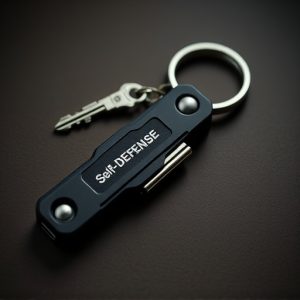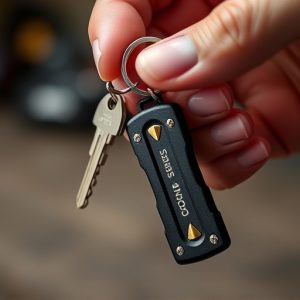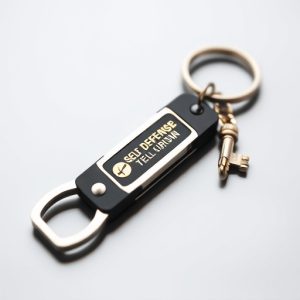Legal Non-Lethal Keychain Weapons: States and Self-Defense Trends
The legality of non-lethal keychain weapons varies across US states, with some permitting open carry…….
The legality of non-lethal keychain weapons varies across US states, with some permitting open carry and others restricting them to concealed possession only. These tools, including stun guns, pepper spray, and knuckles, are gaining popularity as discrete self-defense options. Users must understand local regulations regarding capacity limits, age restrictions, and permitted locations, aligning with 'need-to-carry' or 'stand-your-ground' philosophies. Many states now include protective keyring devices in their list of legal carry items, reflecting a growing acceptance of non-lethal personal defense options that prioritize prevention and preparedness. It's crucial to check local laws before carrying any non-lethal keychain weapon to ensure compliance and promote safety.
“Non-lethal keychain weapons, also known as ‘protective keyrings,’ are gaining traction as personal defense tools. This article explores the legal landscape surrounding these compact devices in various states, offering a comprehensive guide for citizens interested in self-defense options. We delve into the different types of non-lethal gadgets permitted by law and provide insights on carry regulations and safety. Additionally, we analyze the growing trend, its impact, and what the future holds for protective keyring devices.”
- Understanding Non-Lethal Keychain Weapons: A Legal Overview
- States Embracing the 'Protective Keyring' Trend
- Types of Legal Non-Lethal Self-Defense Devices
- Carry Regulations and Safety Considerations
- The Impact and Future of Protective Keyring Devices
Understanding Non-Lethal Keychain Weapons: A Legal Overview
Non-lethal keychain weapons, often referred to as self-defense tools or personal protection devices, have gained popularity for their compact size and convenience. These small gadgets are designed to cause temporary disorientation, pain, or restraint, enabling users to escape potentially harmful situations. However, understanding their legal status is crucial before considering carrying one.
In the United States, the legality of non-lethal keychain weapons varies across states, with some permitting their open carry and others restricting them to concealed possession only. The definition of ‘non-lethal’ can also differ, ranging from stun guns, pepper spray, to knuckles or flashlights with specialized features. It’s essential for individuals in states where these devices are allowed to familiarize themselves with local regulations, including any restrictions on capacity, age limits, and permitted locations (e.g., schools, courts). States that permit non-lethal keychain weapons usually follow a ‘need-to-carry’ or ‘stand-your-ground’ philosophy, ensuring citizens can protect themselves without excessive force.
States Embracing the 'Protective Keyring' Trend
In recent years, a growing trend has emerged across various states in the US, where lawmakers are increasingly recognizing and legalizing the use of ‘protective keyring’ devices. These innovative tools, often disguised as simple keychains, offer non-lethal means for self-defense, providing individuals with an additional layer of personal safety while embracing modern security needs. Many states have now included these protective keyrings in their list of legal carry items, acknowledging the need for accessible and discreet self-defense options.
The appeal lies in their compact design, making them easily portable and allowing users to be prepared for unexpected situations. With a simple twist or click, these keyrings deploy defensive tools such as pepper spray or high-intensity flashlights, enabling individuals to deter potential threats. This trend reflects a changing perspective on self-defense, where prevention and preparedness are prioritized, offering a non-lethal alternative to traditional firearms for those seeking added security without the need for extensive training.
Types of Legal Non-Lethal Self-Defense Devices
In many places, individuals are permitted to carry non-lethal self-defense devices for personal safety. When it comes to keychains, there are various options designed for legal and effective self-protection. One popular choice is the pepper spray keychain, which allows users to defend themselves against potential attackers at close range. These sprays can temporarily disable an assailant, providing enough time for escape or help arrival.
Another type of non-lethal keychain weapon is the stun gun, also known as an electronic control device (ECD). Stun guns emit a powerful electric shock that disrupts muscle control, making it difficult for an aggressor to continue attacking. They are widely used by law enforcement and civilians alike due to their effectiveness and relatively low risk of causing permanent harm. Always check local laws regarding the specific requirements for stun gun size, voltage, and carry permit when considering such a device as a legal non-lethal self-defense option in your state.
Carry Regulations and Safety Considerations
In many regions, the carrying of non-lethal keychain weapons is regulated by specific laws and safety considerations. The legal framework surrounding these devices varies widely from state to state, with some allowing their open carry while others restrict them to concealed possession. Understanding these regulations is crucial for ensuring compliance and promoting safety.
Carrying any type of weapon, including non-lethal keychain ones, requires a responsible approach. Users must be aware of local laws, act within legal boundaries, and prioritize safety above all else. Proper training on the use and handling of such devices can help prevent accidents and ensure their effective deployment only when necessary.
The Impact and Future of Protective Keyring Devices
The future of protective keyring devices looks promising, especially with the growing acceptance and demand for non-lethal personal defense options. As more states begin to recognize the value of such tools, their legal status becomes more secure. These compact devices offer a sense of security, allowing individuals to protect themselves in various situations without resorting to lethal force. With the right legislation in place, they can empower people while ensuring public safety.
The impact of protective keyrings extends beyond individual protection; it contributes to a broader culture of self-defense awareness and preparedness. As awareness spreads about their effectiveness as personal defense tools, more individuals may choose to carry them for added peace of mind. This shift could potentially reduce crime rates, as potential offenders may think twice before targeting someone armed with a non-lethal weapon. The trend towards legalizing these devices reflects a changing societal attitude towards self-defense and public safety.
In conclusion, protective keyring devices have emerged as a popular non-lethal self-defense option, with many states embracing their legal carry status. These compact tools offer individuals enhanced safety and peace of mind in various situations. As the trend continues to grow, it’s essential for users and advocates alike to stay informed about local regulations and safety practices surrounding non-lethal keychain weapons. With proper understanding and responsible use, these devices have the potential to revolutionize personal protection while navigating everyday life’s challenges.


